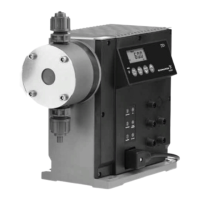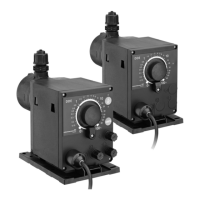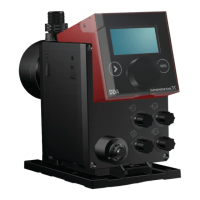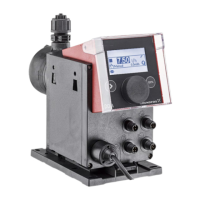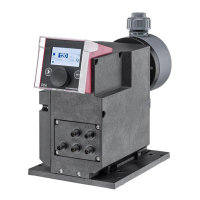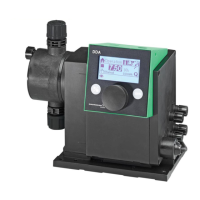English (GB)
46
10. Maintenance
10.1 General notes
10.2 Maintenance intervals
• At least every 12 months or after 4,000 operating hours.
When dosing crystallising liquids, more frequently.
• In the event of a fault.
10.2.1 Cleaning
• If necessary, clean all pump surfaces with a dry and clean
cloth.
10.2.2 Cleaning the valves and diaphragm
• Clean the diaphragm and valves and replace, if necessary (for
stainless-steel valves: inner valve parts).
10.3 Cleaning suction and discharge valves
10.3.1 Switching off the pump
1. Switch off the pump and disconnect it from the power supply.
2. Depressurise the system.
3. Take suitable steps to ensure that the returning dosing
medium is safely collected.
10.3.2 Unscrewing suction and discharge valves / cleaning
valves
1. Unscrew the suction and discharge valves.
2. Remove the screw part and valve seat with round nose pliers.
3. Dismantle the inner parts.
4. Clean all parts. Replace faulty parts by new ones.
– For plastic DN 8 valve, replace the valve completely.
– For stainless-steel DN 8 valve or DN 20 valve, replace the
inner valve parts.
5. Re-assemble the valve.
6. Replace the O-rings by new ones. Refit the valve.
Fig. 54 Stainless-steel or plastic DN 20 valve, spring-loaded
as an option
Fig. 55 Stainless-steel or plastic DN 20 valve, spring-loaded
as an option
Warning
When dosing dangerous media, observe the
corresponding safety precautions!
Risk of chemical burns!
Wear protective clothing (gloves and goggles)
when working on the dosing head, connections
or lines!
Do not allow any chemicals to leak from the
pump. Collect and dispose of all chemicals
correctly!
Warning
The pump housing must only be opened by
personnel authorised by Grundfos!
Repair must only be carried out by authorised
and qualified personnel!
Switch off the pump and disconnect it from the
power supply before carrying out maintenance
work and repair!
In the event of a diaphragm leakage, the dosing
liquid may leak out of the hole in the intermediate
flange between the pump and the dosing head.
The parts inside the housing are protected from
the dosing liquid for a short time (depending on
the type of liquid) by the housing sealing. It is
necessary to check regularly (daily) if liquid is
leaking out of the intermediate flange.
Observe section 10.5 Diaphragm breakage
For maximum safety, we recommend the pump
version with diaphragm leakage detection.
If possible, rinse the dosing head, e.g. by
flushing it with water.
TM03 6685 4506TM03 6686 4506
The O-rings must be correctly placed in the
specified groove.
Observe the flow direction (indicated by an arrow
on the valve body)!
Only tighten the valve by hand.

